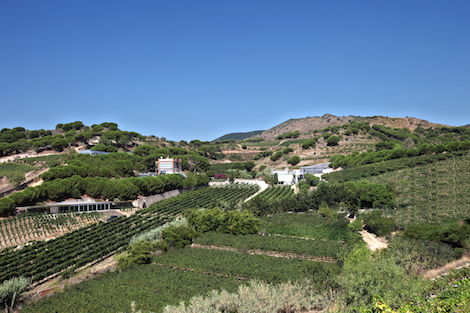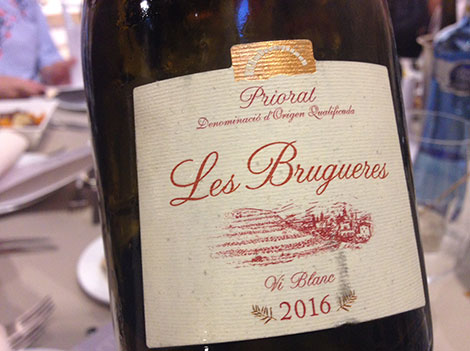
The table at Josep María Pujol-Busquets’ office is a pristine white canvas, with not a single pile of messy papers on sight altering the peace that filters through the great window overlooking the vineyards and the Mediterranean sea, barely two kilometres away. “I’ve always been pretty chaotic, but time has made me be more tidy. When you have people involved in your business, you have an obligation to do things well”, explains this Catalan producer of cavas and still wines with almost 30 years’ experience under his belt.
Nowadays Alta Alella employs around 20 people, a considerable growth since 1991 when Pujol-Busquets and his wife Cristina Guillén invested their savings in the Can Genís estate in Serralada de la Marina Natural Park, 10km north of Barcelona, where they live and work. In this idyllic château with views of the sea and safe from the city’s real estate pressures, they planted six hectares with organic Pansa Blanca (as Xarel.lo is locally known) and Mataró (Monastrell), a variety which fell out of favour in the area after phylloxera. Nowadays, it is one of their star grapes.
“The first cava in Spain was made with Mataró grapes. Grapegrowers lost interest in it because it was a red variety and thus unfashionable and because they wanted resistant varieties capable of producing many kilos of larges grapes. That’s how we got Xarel.lo, Macabeo etc.”, explains Pujol-Busquets. “Australians also call it Mataró, but it is part of our legacy and bears our name”.
New vineyards have been added to the estate’s initial six. Now Alta Alella controls 60 hectares in the Alella and Cava appellations —all of them organically certified— of which 25 are owned and are spread in more than 100 plots. Most of them, including the impressive amphitheater of vines with views of Barcelona above the masía where the family lives, grow on sauló soils —decomposed granite without lime or organic matter which helps to give acidity to the wines.
At the Alta Alella cellar, excavated in the rock, the grape varieties they work with—mostly Pansa Blanca, as well as Macabeo, Monastrell, Chardonnay, Parellada, Syrah, Pansa Rosada and Garnatxa— are vinified separately and in small batches meaning that there can be up to 50 different base wines. “The best moment in the cellar comes when it’s time to choose which tanks are blended and bottled; that’s when all the work we’ve done comes into play”, explains Josep María.
Although they have just sold their cava brand Privat to the group Perelada, their range of wines is significant, with over 20 bottlings divided in three brands: Alta Alella (organic wines), Alta Alella Mirgin (organic cavas, including AA Mirgin Vallcirera, set to be one of the new Cavas de Paraje Calificado) and Alta Alella Celler de les Aus (cavas and natural wines). Most of the wines can be found in Spain at Lavinia; other options via Wine Searcher.
Transparency and organic principles
Organic production is one of the cornerstones of Pujol-Busquets since the beginning, along with the search for wines that reflect the area’s terroir and vintage variations rather than varietal character. He is in favour of allowing foreign varieties in the area, even for the new Cavas de Paraje Calificado.
“In this premium category and with this kind of ageing, it doesn’t make sense to look for varietal notes; terroir identity should be desirable. The aim is to have a grape variety that helps the wine age well, which brings acidity, fine bubbles, character and body. We have Chardonnay vines since 1981; this variety is well-suited for prolonged ageing. The older the vines are the more they talk to you”, adds Pujol-Busquets, who worked as technical director for cava house Parxet for many years.
Beyond the varieties, he praises the fact that this new quality category has been finally linked to the vineyards, a tool to help define cava better. “I would have like them all to be organic, but I think we are on the right track. Until now, the only thing that mattered was the method (dosage, ageing, winemaking…) but this step is a very important move towards quality, beyond traceability on paper. DO Cava has strict rules and everything is tasted”, he claims.
In his search for transparency, Pujol-Busquets started to take an interest on natural wines. “We made Spain’s first cava without added sulfites 11 years ago with the idea of elevating cava’s perception to the level of wine. We thought it was worth trying and we knew that the yeasts would protect it”.
What started as just one natural wine has now become a full project with four hectares of vines to make six wines, including AA Bruant Reserva Brut Nature cava (15,90 € at Lavinia) which featured recently as one of our wines of the week. An ad-hoc cellar, integrated in the landscape and built with containers from the nearby port of Barcelona and other environmentally friendly materials, now houses the natural wines. Even the amphorae where wines are fermented are partly made from sauló taken from the Sant Genís estate.
In terms of natural wines, says Josep María, the most important thing is the quality of the grapes: “Wines with no sulfites added need impeccable grapes; otherwise, we don’t know how to make them well”. With a pragmatic rather than romantic vision, he is skeptical of biodynamics (“Perhaps it’s because I’m not religious, but I see it as mythology; there’s no scientific demonstration”) and rejects natural wines with cider-like aromas. “Natural wines open up the spectrum of flavours and bring differentiation but they need to be real wine, they need to be good and they are meant to be enjoyed. Natural wine producers must be able to make perfect wines”.
Adaptation of varieties
According to Pujol-Busquets, who consults for a couple of organic vintners in La Rioja (Osoti) and Tenerife (Altos de Trevejos), a key element to make wines “that talk about the territory and are as healthy as possible” is to have a deeper knowledge of organic production and a selection of plants that are suitably adapted to their surroundings.
With this premise in mind, Alta Alella is involved in an R&D project, as part of Catalan research group Innovi, whose aim is the creation of native varieties which are resistant to fungi and adapted to climate change. Since 2013 they have been working with Swiss specialist Valentin Blattner making sexual crossings of their vines with resistant German varieties which Alta Alella planted for experimental purposes at Can Genís. Their aim is to have their own “VRIAACC" (acronym in Spanish for indigenous resistant varieties adapted to climate change).
From this resistant vines, which have not been treated with copper nor sulfur in the past three years, Alta Alella obtains polen to cross with their Pansa Blanca, Macabeo and Parellada plants, the three varieties most commonly used for Cava.
“I know it’s not an easy subject to explain and there’s a big chance of demagoguery but I firmly believe that we cannot keep treating the vineyard with chemical products —including copper and sulfur— and insist on saying that we are natural. If we let sexuality play its part, we have good chances to find plants that gradually develop natural resistance to diseases; that’s the evolution of species. The unnatural things are plant cuttings and clones”, insists Pujol-Busquets.
Switzerland and Germany are are at the forefront in this issue, and Italy also has a few companies selling resistant varieties. In Spain, according to Pujol-Busquets, other than a genetic improvement of Monastrell study developed by the regional government of Murcia, in southeastern Spain, there are few initiatives and all of them are private and have no financial support from the state.
Despite the cost of this research and the little debate generated by this issue, Alta Allela firmly believes that the future lies on having plants that are adapted to their surroundings. “This is a small business and I live here with my family. How am I going to treat my vines with pesticides? wonders Josep María. “Organics cannot stop and it must go forward with scientific research focused on healthy practices. Wine cannot have additives and residues hence the need for resistant plants”.
This philosophy along with the family estate does have continuity: his eldest daughter Mireia is gradually assuming Josep María’s responsibilities. Trained as a biologist, sommelier and master in Organic Agriculture, Mireia has grown among the vines and Can Genís’ sauló soils. There’s no doubt that she is perfectly adapted to this environment.

Yolanda Ortiz de Arri
A journalist with over 25 years' experience in national and international media. WSET3, wine educator and translator
NEWSLETTER
Join our community of Spanish wine lovers





